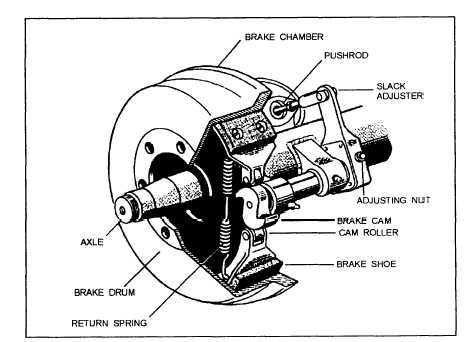AIR BRAKES
Air brakes use compressed air to make the brakes
work. They provide a safe way to stop large vehicles
when maintained and used correctly. The air brake
system is composed of three combined braking systems:
the service brake system, the parking brake system, and
the emergency brake system.
The service brake system applies and releases the
brakes when you use the brake pedal during normal
driving. The parking brake system applies and releases
the parking brakes when you use the parking brake
control. The emergency brake system uses parts of the
service and parking brake system to stop the vehicle in
the event of a brake system failure.
NOTE: The components of the air brake system are
covered in chapter 3.
Brake Drums, Shoes, and Linings
Brake drums are located on each end of the axles.
The wheels are bolted to the drums, and the braking
mechanisms are located inside the drum. The brake
shoes and linings are pushed against the inside of the
drum, and this action causes friction that slows the
vehicle and brings it to a stop. This friction creates heat
on how hard and how long the brakes are used. Too
much heat can stop the brakes from working properly.
S-CAM AIR BRAKES.— When the air brake
pedal is pushed, air is let into each brake chamber
(fig. 7-10). Air pressure pushes the rod out, moving the
slack adjuster, thus twisting the brake camshaft. This
action turns the S-cam that forces the brake shoes away
from one another and presses them against the inside of
the brake drum. When the brake pedal is released, the
S-cam rotates back and a spring pulls the brake shoes
away from the drum, allowing the wheels to roll freely.
WEDGE BRAKES.— On wedge brakes, the brake
chamber pushrod pushes a wedge directly between the
ends of two brake shoes. The wedge shoves the shoes
apart and against the inside of the brake drum. Wedge
brakes have either a single-brake chamber or two brake
chambers that push wedges into both ends of the brake
shoes.
DISC BRAKES.— The air pressure in air-operated
disc brakes acts on a brake chamber that produces
movement of the slack adjuster, like on the S-cam brake.
But instead of the S-cam, a “power screw” is used. The
pressure of the brake chamber on the slack adjuster turns
the power screw. The power screw clamps the disc or
rotor between the brake lining pads of a caliper.
NOTE: Wedge and disc air brakes are less common
and the heat a drum can take without damage depends
than the S-cam brake.
Figure 7-10.—S-cam air brake.
7-9

